
Category: Vault-Treasure Tuesdays
Some older recordings make you want to ask, “How much have we really learned in 50 or 60 years?”
Christmas Music (Part 1): Nat King Cole, “Christmas Favorites”
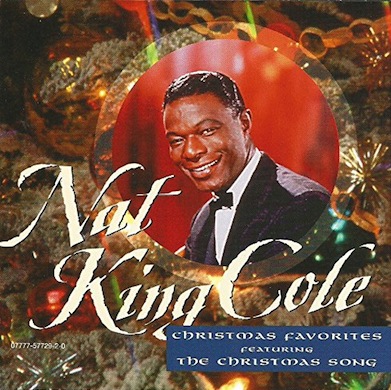
Velvet-voiced pop and jazz tenor Mel Tormé (1925-1999) and songwriter Bob Wells wrote “The Christmas Song” in less than an hour, one sweltering day during the summer of 1945. Tormé wrote the music, and collaborated on the lyrics. (That Tormé’s parents were Jewish immigrants from Russia did not stop Tormé from writing what is generally regarded as the most popular and beloved English-language Christmas song of the pop-music era.) Tormé had been a child-prodigy singer and drummer; he was also a composer and arranger.
Though revered as an interpreter of Great American Songbook songs, Tormé’s musical worldview included deep respect for classical composers Frederick Delius and Percy Grainger (talk about strange musical bedfellows). Rock and roll, he liked not so much. Tormé’s essential musical conservatism endeared him to Playboy magazine founder Hugh Hefner. (And if anyone out there needs a Media Studies, American Studies, or Musicology research topic, I nominate Hugh Hefner’s role in keeping jazz on life support in the US during the ascendancy of rock music.)
Nat King Cole sound samples (some not so obvious) and more pensiveness, after the jump. Continue Reading →
Alexander Kerr, Rhode Island Philharmonic, Barber Violin Concerto
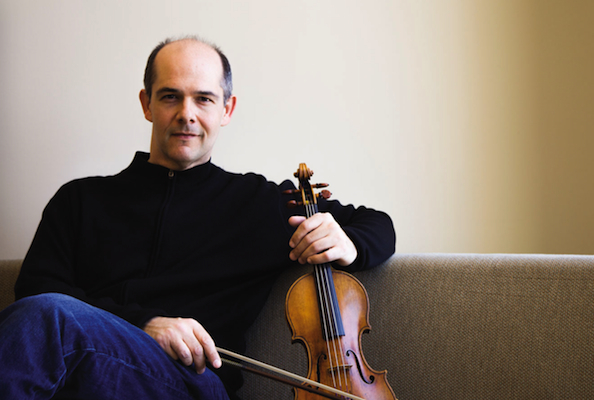
Over the course of time I have owned recordings of Brahms’ violin concerto by at least 14 different violinists. For a few of those violinists, I obtained recordings of more than one performance. And for one performance, David Oistrakh’s 1969 away game with George Szell and the Cleveland Orchestra, I collected multiple formats (LP, CD, and SACD), including at least half a dozen different LP pressings ultimately (and however multifariously) derived from the same original master tape. (OK, call me a bit barmy.)
The violinists whose Brahms concerto performances I purchased and kept (rather than passed along or donated) ranged from Kreisler and Menuhin and Heifetz and Kremer to… Uto Ughi. To say the least, Cavalier Uto’s career in the US has not been, um, huge. From the violinists whose names were not household, my favorite recording was by Hermann Krebbers. Krebbers, who was perhaps as little-known in the US as Ughi, recorded the Brahms concerto with Bernard Haitink and the Royal Concertgebouw Orchestra in 1973.
Please click on the jump link to learn the relevance of all that to Alexander Kerr’s truly wonderful Barber concerto performance with the Rhode Island Philharmonic, as well as an embedded audio-only YouTube of Kerr’s Decca recording of a charming Shostakovich film-score number. Continue Reading →
Emerson Quartet: J.S. Bach, The Art of the Fugue
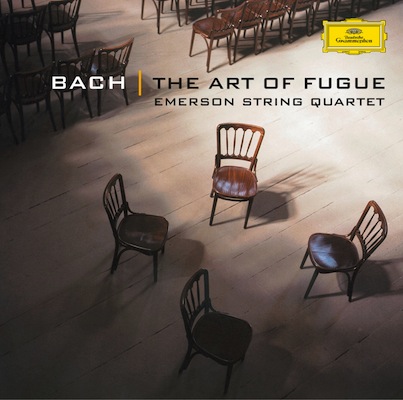 Courtesy of Deutsche Grammophon; cover photo by Marco Borggreve.
Courtesy of Deutsche Grammophon; cover photo by Marco Borggreve.
The Emerson String Quartet: J.S. Bach, The Art of the Fugue, BWV 1080
CD Deutsche Grammophon 474 495-2
(Streaming via Tidal; no hi-res download appears available.)
Recorded January and February 2003 at the American Academy of Arts and Letters, New York City. Da-Hong Seetoo, producer and engineer.
One of the bits of musical non-trivia that I have carted around me for ages is the fact that American composer Roy Harris (whose third symphony is for me the best example of mid-twentieth-century, typically exuberant American musical creativity) also, with collaborator M.D. Herter Norton transcribed for string quartet Bach’s The Art of the Fugue.
M.D. Herter Norton, by the way, was Margaret (also sometimes Mary; and, informally Polly) Dows Herter, who with her husband W.W. Norton founded the publishing firm that bears his name. (W.W. Norton is still a major publisher—if not the major publisher—of music-history texts and anthologies for college use in the English-speaking world.) Margaret Norton was a violinist, an independent scholar of music, and translator from the German of about a dozen volumes of the poetry of Rainer Maria Rilke. She was very important in the early years of the American Musicological Society, as well as co-authoring, editing, or translating articles for the The Musical Quarterly.
After the jump, there is a scan of the cover of that score, from 1936. And generous sound samples. I think most music lovers will find this CD (or the stream from Tidal) extremely rewarding.
L. Subramaniam: Electric Modes
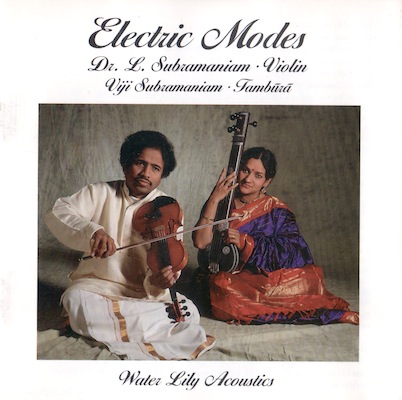
Lakshminarayana Subramaniam: Electric Modes
L. Subramaniam, electric violin; Viji Subramaniam, tambura; uncredited musicians, mridangam and ghatam.
2-CD set Water Lily Acoustics WLA-ES-5&6 (o.o.p.)
Recorded May 1987, Our Lady of Mount Carmel, Santa Barbara; November 1987, Unitarian Church, Santa Barbara; and September 1990, First Presbyterian Church, Santa Barbara. L. Subramaniam and Kavichandran Alexander, producers; Kavichandran Alexander, engineer. (Available via streaming from Tidal; via streaming and MP3 downloads from Amazon; from iTunes; used CDs and LPs are found on eBay and Amazon.)
California’s audiophile label Water Lily Acoustics achieved the dream of most independent music producers by winning the Grammy award in 1994 for Ry Cooder and V.M. Bhatt’s A Meeting By the River. No question, that is a very worthwhile recording.
However, that said, if I had to pick one recording from the Water Lily catalog that was even more musically substantial, it would be L. Subramaniam’s Muddy Waters-inspired Electric Modes. The sound samples over the jump are rather mind-boggling. The original LPs and the CD reissue are long out of print, but through the magic of streaming services, this magnificent music is readily available.
Some background, and the rather stunning sound samples, after the jump. Continue Reading →
Morten Lauridsen: “Lux Æterna”
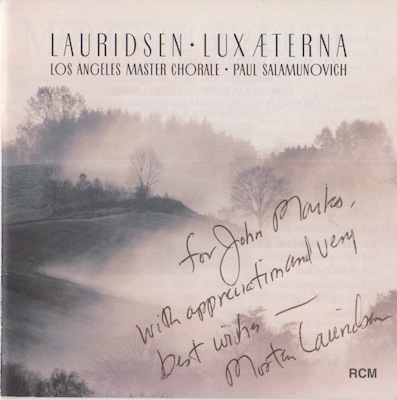
Morten Lauridsen: Lux Æterna and other works
Los Angeles Master Chorale and Sinfonia, Paul Salamunovich, conductor
CD Rubedo Canis Musica RCM 19705
Recorded June 1997 to January 1998, Sacred Heart Chapel, Loyola Marymount University, Los Angeles; Peter Rutenberg, producer; Fred Vogler, engineer.
This recording of Morten Lauridsen’s Lux Æterna was nominated for the Grammy award in its category in 1999. A quick listen to the beginning will tell you why. (A Robert Shaw CD won the award, understandably as it was the year of his death.) Lux Æterna starts with a stroke of genius, and then goes on from strength to strength. The first thing you hear is one of the tallest yet emptiest chords in concert music—the string basses lay down a granite foundation while the high strings harmonize from, it seems, light-years away. And there is nothing in between.
That inspired gesture announces the work as hugely ambitious, while being completely self-assured. Lauridsen is making his personal statement about the meaning of human existence, and nothing less than that. Lux Æterna is one of the masterpieces of the 20th century, and you are really missing out if you have not heard it.
Generous sound samples and more, after the jump. Continue Reading →
“Le Grand Tango”: Music of Astor Piazzolla
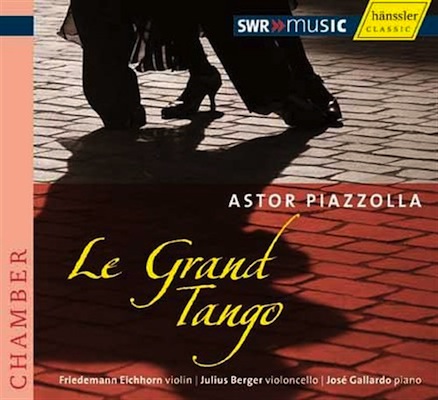
Le Grand Tango: Music of Astor Piazzolla
Recorded March 2005, SWR Funkhaus Mainz
CD SWR KLASSIK 93205
Download (CD Quality Only)
José Gallardo, piano; Friedemann Eichhorn, violin; Julius Berger, cello; José Bragato and Osvaldo Calo, arrangers; Peter Steiber and Sabine Fallerstein, producers; Angela Öztanil, engineer.
Astor Piazzolla (1921-1992) was best known as a performer of his own modernized tango music. His instrument was an unusual concertina (button accordion) called the Bandoneón. The Bandoneón was originally designed (in Germany) as an inexpensive substitute for a church organ, providing chordal accompaniment to congregational hymn singing. That intended use dictated the inner logic of its workings. So the Bandoneon plays different notes from the same fingering, depending whether the bellows was being pushed together or pulled apart. That quirk makes Piazzolla’s brilliant solo work even more impressive… .
But Piazzolla was more than an electrifying live performer; he was a serious composer. The Hungarian classical pianist Bela Wilda, who introduced Piazzolla to Bach, himself had been a student of Rachmaninoff’s. Piazzolla briefly was a student of Nadia Boulanger’s (she sent him on his way, though, urging him to find his own path). Piazzolla spent five years studying orchestration with Alberto Ginistera. Piazzolla put that training to use over the rest of his life, eventually writing more than 60 film scores. That sensibility is what makes this very well recorded, infectiously listenable album a “must-buy.” Just buy it! Continue Reading →
Danny Infantino: “More… Songs Without Words”
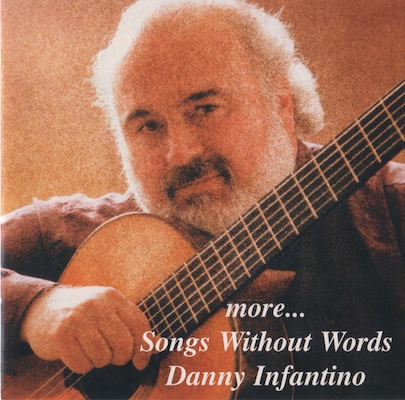
Danny Infantino: More… Songs Without Words
CD Duns Scotus Recordings 002 (recorded 1995)
(No high-resolution download available, apparently.)
Danny Infantino, solo classical guitar and producer; Wes Lachot, engineer; Brent Lambert, mastering.
I got in touch years ago with Danny Infantino when I saw his company name (Duns Scotus) listed in some independent-music publication–perhaps something from the AFIM. I got a kick out of the idea that someone would name an independent record label after one of the pre-Scholastic Medieval theologians. He sent me his CDs and I was very very impressed. Years later, Stereophile‘s John Atkinson visited me and I played some of Danny’s music for him. JA, upon his return to New York, ordered the CDs directly from the artist.
This CD is a reminder, in the same way the David Nadien Swan Lake concertmaster-solo video was, that there is a shockingly weak linkage between musical quality and career and marketplace success. Danny’s technique is surpassed only by his musicianship. So, not much more to say than, click on the jump link, listen to the sound samples, and order this CD! More… Songs Without Words is available from eBay, from third-party sellers on Amazon, and directly from the artist. Just buy it. Continue Reading →
Rodion Shchedrin: “Carmen-Suite,” after Bizet
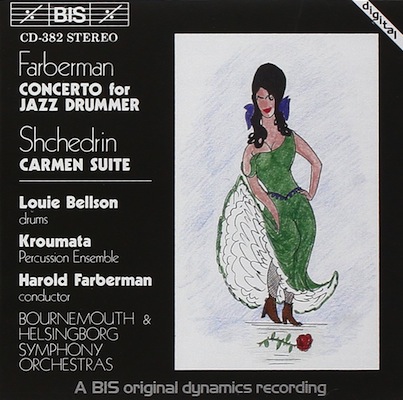
Rodion Shchedrin: Carmen-Suite for strings and 47 percussion instruments, after Bizet (written 1967)
CD BIS 382 (recorded 1987)
(No high-resolution download available, apparently.)
Kroumata Percussion Ensemble, Helsingborg Symphony Orchestra, Howard Faberman, conductor; Robert von Bahr, producer; Siegbert Ernst, engineer.
Talk about a Guilty Pleasure. An email from Jason McCrary of Reference Audio (one of my Esperanto Audio dealers) finally made me sit down and listen all the way through Rodion Shchedrin’s Carmen-Suite, from the 1967 Alberto Alonso ballet. An LP-loving (and vacuum-tube-loving) customer had turned Jason on to the EMI LP with Gennady Rozhdestvensky and the Bolshoi Theatre Orchestra. The original of that LP is out of print. According to the LP-sales database Popsike, it has fetched between $21 and $142 used, with a median of $48, and a mean of $54. There is (or was) a 180-gram LP reissue (at least in Germany and Switzerland).
The guilty-pleasure aspects of Shchedrin’s score are first the orchestration—strings only, plus four percussionists playing a total of 47 different percussion instruments (to give that word a very wide scope)—while the other guilty pleasure is the affectionate cheekiness of Shchedrin’s musical tamperings. Continue Reading →
Jane Monheit: “Taking a Chance on Love”
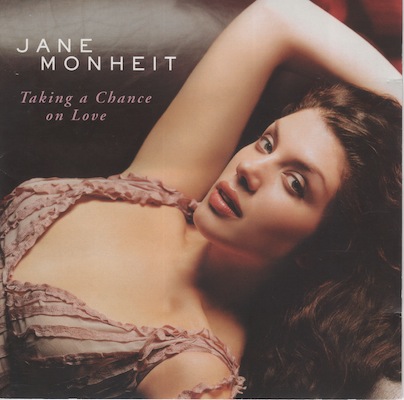
Jane Monheit: Taking a Chance on Love
Recorded at Avatar Studios, NYC, March-May 2004; released on CD September 2004.
CD Sony Classical SK 92495
(No high-resolution download found.)
Jane Monheit, vocals; Michael Kanan, piano; Orlando Le Fleming, bass; Rick Montalbano, drums; Miles Okazaki, guitar; various guests; Alan Broadbent, arranger and conductor; Peter Asher and Al Schmitt, producers; Al Schmitt, engineer.
“Great American Songbook” singer Jane Monheit’s début studio album for Sony Classical Taking a Chance on Love is in many ways the opposite bookend to Harry Connick, Jr.’s We Are In Love, which I wrote about here. After all, both titles use the “L” word… .
However, the important difference is that Harry Connick’s voice is of the “boy next door” variety, whereas Jane Monheit’s voice is of the “girl next door” variety, but only if you live next door to the Manhattan School of Music. Monheit’s own website is here; her Wiki is here.
Sound bytes, a YouTube, and more, on the continuation page. Continue Reading →
Bob Ludwig on Shostakovich and Beethoven
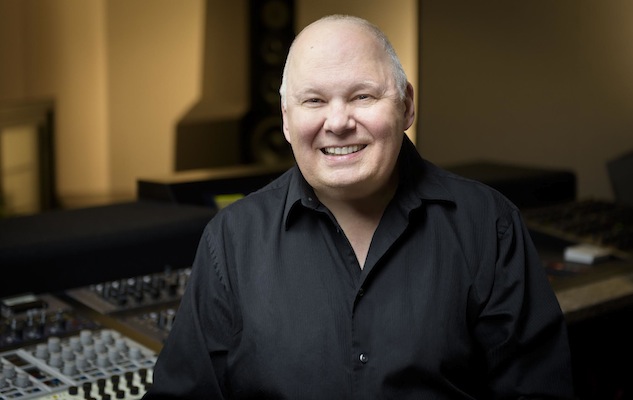
(Photo © Vincent Dixon, courtesy of Gateway Mastering.)
A few postings back, I suggested that, consciously or otherwise, Dmitri Shostakovich modeled the brief but arresting four-note musical motto that begins the Passacaglia theme of the third movement of his violin concerto on Beethoven’s famous four-note beginning of the first movement of his Fifth Symphony.
In other words, instead of Beethoven’s
da-da-da DAAH…
Shostakovich opens with
DAAH, da DA-DA.
That was in the context of a Vault-Treasure Tuesday feature, David Oistrakh’s première studio recording of 1956.
I sent the link to Bob Ludwig, and Bob sent back a fascinating response. A bit about Bob, and then his important contribution to the conversation, are after the jump. Continue Reading →


